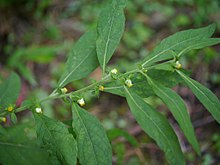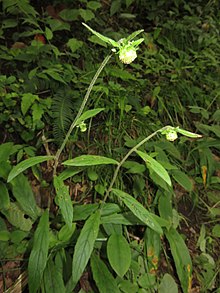Collar flowers
| Collar flowers | ||||||||||||
|---|---|---|---|---|---|---|---|---|---|---|---|---|

Nodding collar flower ( Carpesium cernuum ) |
||||||||||||
| Systematics | ||||||||||||
|
||||||||||||
| Scientific name | ||||||||||||
| Carpesium | ||||||||||||
| L. |
The plant genus collar flower ( Carpesium ) belongs to the family of the daisy family (Asteraceae). The 20 or so species are common in Eurasia , 16 of which are found in China.
description
Appearance and leaves
The collar flower species rarely grow as annual , mostly as perennial herbaceous plants . Most of the time the stems are branched. The wechselstängig arranged on the stems leaves can be stalked. If there are petioles, then they are often winged. The simple leaf blades have a smooth or serrated leaf margin.
Inflorescences and flowers
Most hanging, basket-shaped part inflorescences are sitting or sometimes individually short Blütenstandsschäften to few or many are terminally or laterally ährig traubigen total inflorescences on the stems. The disc - shaped, cup - shaped inflorescences are so-called pseudoanthias ; From an ecological point of view, they are flowers and contain many individual flowers. The hemispherical or flattened involucre consists of three or four rows of bracts (called phyllaria). The outer bracts are herbaceous or have herbaceous tips and the inner ones are dry, broad with a blunt upper end. The flat base of the inflorescence (receptaculum) is smooth and there are no chaff leaves.
There are often ray and tubular flowers in the flower heads. There are no ray florets in Carpesium cernuum . At the edge of the flower head there are two or more rows of ray- flowers , also called ray-flowers; they are female and fertile with corolla tubes ending in three to five coronet teeth. In the center of the flower head there are many tubular flowers , also called disc flowers; they are hermaphroditic and fertile and their slender, yellowish corolla tubes end in four or five coronet teeth. The style branches of the tubular flowers are very flat and blunt and have pointed purging hairs.
fruit
The bald, ellipsoidal achenes are ribbed and longer than the corolla. The achenes have a short, glandular beak at the top, which is crowned by a cartilaginous ring with elongated crystals. There is no pappus .
Chromosome numbers
The basic chromosome number is x = 10, 18.
Systematics and distribution
The distribution areas of the approximately 20 Carpesium species are in Eurasia . There are 16 in China, 6 of them only there. Five species are found in Taiwan. The nodding collar flower ( Carpesium cernuum ) has a wide distribution from southern Europe over the Mediterranean area to the Middle East over large areas of the Asian continent to Southeast Asia and is also found in Australia.
The genus Carpesium was established in 1753 by Carl von Linné in Species Plantarum , 2, p. 859. Type species is Carpesium abrotanoides L.
The genus Carpesium belongs to the tribe Inuleae in the subfamily Asteroideae within the family Asteraceae .
There are about 20 types of Carpesium :
- Carpesium abrotanoides L .: It is widespread in Italy, Croatia, Serbia, Hungary and Albania, in the Middle East, in the Caucasus, in Russia, Iran, Afghanistan, Bhutan, Nepal, India, Myanmar, China, Korea, Vietnam and Japan.
- Nodding collar flower ( Carpesium cernuum L. , Syn .: Carpesium spathiforme Hosok. ): It is widespread in the Old World from southern Europe over the Mediterranean area to Western Asia over large areas of the Asian continent to Southeast Asia and is also found in Australia.
- Carpesium cordatum F.H.Chen & CMHu : It occurs in India, Nepal and in the Chinese provinces of Xizang , Sichuan and Yunnan .
- Carpesium divaricatum Siebold & Zucc. : It occurs in China, Korea and Japan.
- Carpesium faberi C. Winkl. (Syn .: Carpesium hosokawae Kitamura , Carpesium k Weichowense C.C.Chang ): It occurs in Japan and Taiwan as well as in the Chinese provinces of Guangxi , Guizhou , Hubei , Sichuan.
- Carpesium glossophyllum Maxim. (Syn .: Carpesium hieracioides H.Lév. ): It occurs in Korea and Japan.
- Carpesium humile C. Winkl. : It thrives on grassy slopes, banks of rivers and forest edges at altitudes between 2000 and 3700 meters in the Chinese provinces of Gansu , Qinghai , Sichuan, Xizang and Yunnan.
- Carpesium lipskyi C. Winkl. : It thrives on the edges of forests and in bushes at altitudes between 2000 and 3700 meters in the Chinese provinces of Gansu, Qinghai, Sichuan, Shanxi and Yunnan.
- Carpesium longifolium F.H.Chen & CMHu (Syn .: Carpesium leptophyllum F.H.Chen & CMHu ): It thrives in moist forests and rivers and on grasslands at altitudes between 600 and 2300 meters in the Chinese provinces of Gansu, Guizhou, Hubei , Shaanxi and Sichuan.
- Carpesium macrocephalum Franch. & Sav. : It occurs in Russia, China, Korea and Japan.
- Carpesium minus Hemsl. : It thrives on grassy slopes along rivers at altitudes between 700 and 1000 meters in the Chinese provinces of Hubei, Hunan , Jiangxi , Sichuan and Yunnan. So far it has sometimes been confused with Carpesium faberi .
- Carpesium nepalense Less. (Syn .: Carpesium verbascifolium H.Lév. ): It occurs in India, Pakistan, Bhutan, Nepal, China and Taiwan.
- Carpesium rosulatum Miq. : It occurs in Korea and Japan.
- Carpesium scapiforme F.H.Chen & CMHu : It occurs in India, Bhutan, Nepal and China.
- Carpesium szechuanense F.H.Chen & CMHu : It thrives on grassy slopes and forest edges at altitudes between 1400 and 2500 meters in the Chinese provinces of Hubei, Sichuan and Yunnan.
- Carpesium trachelifolium Less. : It occurs in India, Kashmir , Bhutan, Nepal, China and Taiwan.
- Carpesium dreary Maxim. : It occurs in Russia, China, Korea and Japan.
- Carpesium velutinum C. Winkl. (Syn .: Carpesium zhouquensis J.Q.Fu ): It thrives in forests and on mountain slopes at altitudes between 2000 and 3200 meters in the Chinese provinces of Gansu, Shaanxi and Sichuan.
swell
- Chen Yousheng & Arne Anderberg: Tribe Inuleae , p. 820-845 : Carpesium , p. 821-825 - online with the same text as the printed work , In: Wu Zheng-Yi, Peter H. Raven & Deyuan Hong (editors): Flora of China , Volume 20–21 - Asteraceae , Science Press and Missouri Botanical Garden Press, Beijing and St. Louis, November 12, 2011. ISBN 978-1-935641-07-0 (sections description, distribution and classification)
- Ching-I Peng, Kuo-Fang Chung, Hui-Lin Li: Compositae Giseke. : Carpesium - Digital Flora of Taiwan . (Sections Description, Distribution and Systematics)
Individual evidence
- ↑ First publication scanned in at biodiversitylibrary .
- ^ Carpesium at Tropicos.org. Missouri Botanical Garden, St. Louis
- ↑ Assessment of the recognized species in the Global Compositae Checklist . last accessed on January 20, 2012
- ^ Carpesium in the Germplasm Resources Information Network (GRIN), USDA , ARS , National Genetic Resources Program. National Germplasm Resources Laboratory, Beltsville, Maryland. Retrieved March 5, 2018.




